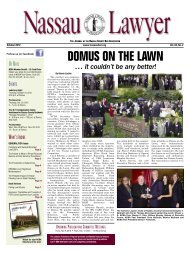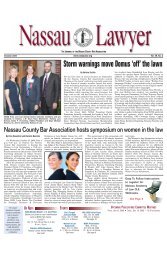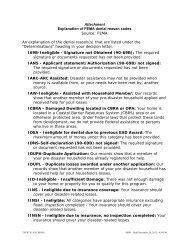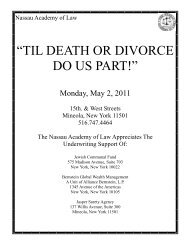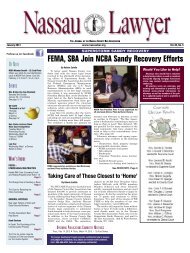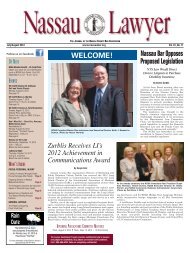394 B.R. 721 Page 18394 B.R. 721, 50 Bankr.Ct.Dec. 192(Cite as: 394 B.R. 721)(8th ed. 2004)("BLACK"), or "to annul, vacate, defeat,evade, invalidate." WEBSTER'S THIRD NEW INTER-NATIONAL DICTIONARY (UNABRIDGED) 151(1981). It is not synonymous with "avoidable." Avoidable,or "voidable," is an adjective. It describes a transactionthat can be voided, id. at 2562, but that is "[v]aliduntil annulled." BLACK 1605. In other words, a transfermust be avoidable in order to be avoided, but until it isavoided, it is as valid as an unavoidable transfer.A significant number <strong>of</strong> cases have read § 550 to requirethat the plaintiff must first (or simultaneously) bring asuccessful suit against the initial transferee before he canrecover the transfer or its value from *742 the subsequenttransferee. [FN21] E.g., Weinman v. Simons (In re Slack-Horner Foundries Co.), 971 F.2d 577, 580 (10thCir.1992)("[I]n order to recover from a subsequent transfereethe trustee must first have the transfer <strong>of</strong> the debtor'sinterest to the initial transferee avoided under § 548");Allou Distribs., 379 B.R. at 19 ("Thus, before the Trusteemay obtain an actual recovery from the Movants under §550(a), he must first avoid the underlying initial transfers.");Geltzer v. Fur Warehouse, Ltd. (In re Furs by Albert& Marc Kaufman, Inc.), Adv. Proc. No. 05-1838,2006 WL 3735621, at * 8 (Bankr.S.D.N.Y. Dec.14,2006)(noting that an "essential element" <strong>of</strong> a trustee'srecovery under § 550(a) was his avoidance <strong>of</strong> the initialtransfer); Williams v. Mortillaro (In re Res., RecyclingRemediation, Inc.), 314 B.R. 62, 69(Bankr.W.D.Pa.2004)("Section 550(a) is a recovery provisionand gives rise to a secondary cause <strong>of</strong> action whichapplies after the trustee has prevailed under one (or more)<strong>of</strong> the avoidance provisions found in the BankruptcyCode."); Yoppolo v. Liberty Mortgage (In re Morgan),276 B.R. 785, 789 (Bankr.N.D.Ohio 2001)(the statutorylanguage <strong>of</strong> § 550 and its legislative history leads to theconclusion that a trustee must first avoid an underlyingtransfer before recovery); Greenwald v. Latham Watkins(In re Trans-End Tech., Inc.), 230 B.R. 101, 104-05(Bankr.N.D.Ohio 1998)(under the plain and unambiguouslanguage <strong>of</strong> § 550(a), a prerequisite to recovery from anytransferee is that the initial transfer first be avoided ratherthan merely proven to be avoidable); Brandt v. Hicks,Muse Co., Inc. (In re Healthco Intl., Inc.), 195 B.R. 971,981-82 (Bankr.D.Mass.1996)("If the initial transfereemakes a second transfer, the property may be recoveredfrom the later transferee only if the transfer is avoidedwith respect to the initial transferee."); Santee v. Nw. NatlBank (In re Mako, Inc.), 127 B.R. 471, 473(Bankr.E.D.Okla.1991)(a cause <strong>of</strong> action under § 550(a)may be brought only after a trustee prevails pursuant tothe transfer avoidance sections <strong>of</strong> the Code).FN21. Enron Corp. v. Intl Fin. Corp. (In re EnronCorp.), 343 B.R. 75 (Bankr.S.D.N.Y.2006),which is frequently cited in support <strong>of</strong> thisproposition, has been reversed. See Order Reversingand Remanding Judgment <strong>of</strong> the BankruptcyCourt, dated Apr. 16, 2008, Adv. Proc.No. 03-93370 (ECF Doc. # 167).An equally significant number <strong>of</strong> cases have reached theopposite result, concluding that the trustee can sue thesubsequent transferee in the first instance, and need proveonly that the initial transfer was avoidable. E.g., IBT Int'l,Inc. v. Northern (In re Int'l Admin. Servs., Inc.), 408 F.3d689, 706 (11th Cir.2005)("[O]nce the plaintiff proves thatan avoidable transfer exists he can then skip over the initialtransferee and recover from those next in line.");Kendall v. Sorani (In re Richmond Produce Co., Inc.),195 B.R. 455, 463 (N.D.Cal.1996)("[O]nce the trusteeproves that a transfer is avoidable under section 548, hemay seek to recover against any transferee, initial or immediate,or an entity for whose benefit the transfer ismade."); Brown v. Phillips (In re Phillips), 379 B.R. 765,780 (Bankr.N.D.Ill.2007)("A court must first make a determinationwhether the transfer was fraudulent underapplicable state law and, therefore, avoidable under §544(b) before that transfer can be recovered pursuant to §550(a)."); Official Comm. <strong>of</strong> Unsecured Creditors v. Foss(In re Felt Mfg. Co., Inc.), 371 B.R. 589, 638(Bankr.D.N.H.2007)(In a recovery action under § 550, itis "sufficient if the complaint asserts that there are avoidabletransfers under state or federal law....");*743Leonard v. Optimal Payments Ltd. (In re Nat'l AuditDef. Network), 332 B.R. 896, 915(Bankr.D.Nev.2005)(adopting the holding <strong>of</strong>International Administrative Services ); Crafts Plus+, Inc.v. Foothill Capital Corp. (In re Crafts Plus+, Inc.), 220B.R. 331, 338 (Bankr.W.D.Tex.1998)("Once it has beenestablished that a qualified transfer has been made, § 550provides for recovery against either the initial transferee... or 'the entity for whose benefit such transfer was made.'"); see Woods & Erickson, LLP v. Leonard (In re AVI,Inc.), 389 B.R. 721, 735 (9th Cir. BAP 2008)("[W]e holdthat a trustee is not required to avoid the initial transferfrom the initial transferee before seeking recovery fromsubsequent transferees under § 550(a)(2)."). In RichmondProduce, District Judge Schwarzer explained that § 550does not contain language suggesting that recovery from asubsequent transferee is dependent on a prior action orrecovery against the initial transferee. The introductory"to the extent that" language in § 550(a) recognizes that© 2009 Thomson Reuters. No Claim to Orig. US Gov. Works.
394 B.R. 721 Page 19394 B.R. 721, 50 Bankr.Ct.Dec. 192(Cite as: 394 B.R. 721)transfers are sometimes avoided only in part, and only theavoidable part is recoverable. 195 B.R. at 463; accordInt'l Admin. Servs., Inc., 408 F.3d at 706. InternationalAdministrative Services also expressed the concern that aninitial transferee could escape liability by retransferringthe property. 408 F.3d at 704.Although § 550 plainly limits recovery to the extent thatthe transfer is actually avoided, it does not follow that the"avoidable" courts reached the wrong result. The casesthat read "to the extent avoided" literally assume that theinitial transferee must be a party to the avoidance action.See Shapiro v. Art Leather, Inc. (In re Connolly N. Am.,LLC), 340 B.R. 829, 839 (Bankr.E.D.Mich.2006). Thedecisions on both sides <strong>of</strong> the issue have focused on thelanguage <strong>of</strong> the Bankruptcy Code because the parties directedtheir attention to that provision. However, theBankruptcy Code, and specifically §§ 544(b) and 548,does not identify the proper, necessary or indispensableparties to a fraudulent transfer action, and does not statethat the initial transferee is necessary. Instead, we mustlook to the Federal Rules <strong>of</strong> Civil Procedure.3. Fed.R.Civ.P. 19[21][22] Federal Civil Rule 19, made applicable to thisadversary proceeding by Federal Bankruptcy Rule 7019,governs the required joinder <strong>of</strong> parties. [FN22] The *744Rule establishes a three-part test to determine whetherjoinder <strong>of</strong> a party is required: (1) is the absent party a"necessary" party, 4 JAMES WM. MOORE, MOORE'SFEDERAL PRACTICE § 19.02[3][a], at 19-17 (3d ed.2008)("MOORE"); (2) is the absent party's joinder "feasible,"id. § 19.02 [3][b], at 19-17 to -18, and (3) if joinderis not feasible, should the court, in "equity and good conscience,"dismiss the action because the nonparty is "indispensable"under Rule 19(b)? Id. § 19.02[3][c], at 19-19; see Provident Tradesmens Bank & Trust Co. v. Patterson,390 U.S. 102, 124, 88 S.Ct. 733, 19 L.Ed.2d 936(1968); Viacom Int'l, Inc. v. Kearney, 212 F.3d 721, 725(2d Cir.2000); Associated Dry Goods Corp. v. TowersFin. Corp., 920 F.2d 1121, 1123 (2d Cir.1990).(B) that person claims an interest relating to thesubject <strong>of</strong> the action and is so situated that disposing<strong>of</strong> the action in the person's absence may:(i) as a practical matter impair or impede the person'sability to protect the interest; or(ii) leave an existing party subject to a substantialrisk <strong>of</strong> incurring double, multiple, or otherinconsistentobligations because <strong>of</strong> the in-wiseterest.....(b) WHEN JOINDER IS NOT FEASIBLE. Ifa person who is required to be joined if feasiblecannot be joined, the court must determinewhether, in equity and good conscience, the actionshould proceed among the existing parties orshould be dismissed. The factors for the court toconsider include:(1) the extent to which a judgment rendered inthe person's absence might prejudice that personor the existing parties;(2) the extent to which any prejudice could belessened or avoided by: (A) protective provisionsin the judgment;(B) shaping the relief; or(C) other measures;(3) whether a judgment rendered in the person'sabsence would be adequate; and(4) whether the plaintiff would have an adequateremedy if the action were dismissed for nonjoin-der.FN22. Rule 19 provides:(a) PERSONS REQUIRED TO BE JOINEDIF FEASIBLE. (1) Required Party. A personwho is subject to service <strong>of</strong> process and whosejoinder will not deprive the court <strong>of</strong> subject matterjurisdiction must be joined as a party if:(A) in that person's absence, the court cannot accordcomplete relief among existing parties; or[23] The Fortgang Affiliates are not necessary partiesunder Rule 19(a)(1)(A). "A Rule 19(a)(1) inquiry is limitedto whether the district court can grant complete reliefto the persons already parties to the action. The effect adecision may have on the absent party is not material."Janney Montgomery Scott, Inc. v. Shepard Niles, Inc., 11F.3d 399, 405 (3d Cir.1993); accord Arkwright-BostonMfrs. Mut. Ins. Co. v. City <strong>of</strong> New York, 762 F.2d 205,209 (2d Cir.1985); Drankwater v. Miller, 830 F.Supp.188, 192 (S.D.N.Y.1993). Here, the plaintiff can obtaincomplete relief by recovering a money judgment againstthe Defendant Banks without regard to the Fortgang Affiliates.[24] In addition, Rule 19(a)(1)(B) does not require theFortgang Affiliates' joinder. Rule 19(a)(1)(B)(i) focuseson the prejudice to the absent party if the litigation proceedsin its absence. The absentee must "claim a legallyprotected interest relating to the subject matter <strong>of</strong> the action,"Northrop Corp. v. McDonnell Douglas Corp., 705© 2009 Thomson Reuters. No Claim to Orig. US Gov. Works.
- Page 1 and 2:
Nassau Academy of LawCLE Live Class
- Page 3 and 4:
McKinney's Debtor and Creditor Law
- Page 5 and 6:
McKinney's Debtor and Creditor Law
- Page 7 and 8:
McKinney's Debtor and Creditor Law
- Page 9 and 10:
McKinney's Debtor and Creditor Law
- Page 11 and 12:
McKinney's Debtor and Creditor Law
- Page 13 and 14:
McKinney's Debtor and Creditor Law
- Page 15 and 16:
McKinney's Debtor and Creditor Law
- Page 17 and 18:
McKinney's Debtor and Creditor Law
- Page 19 and 20:
BAKER & HOSTETLER LLP45 Rockefeller
- Page 21 and 22:
usiness of defendant Bernard L. Mad
- Page 23 and 24:
BACKGROUND, THE TRUSTEE, AND STANDI
- Page 25 and 26:
Madoff who received fraudulent tran
- Page 27 and 28:
ased on fictitious profits and for
- Page 29 and 30:
28. BLMIS funds were also used to p
- Page 31 and 32:
Madoff, and her niece, Shana Madoff
- Page 33 and 34:
42. Ruth Madoff was never an employ
- Page 35 and 36:
FIRST CAUSE OF ACTIONTURNOVER AND A
- Page 37 and 38: 66. At the time of each of the Two-
- Page 39 and 40: Transfers; (b) directing that the S
- Page 41 and 42: EIGHTH CAUSE OF ACTIONUNDISCOVERED
- Page 43 and 44: TENTH CAUSE OF ACTIONDISALLOWANCE O
- Page 45 and 46: 111. Mrs. Madoff benefited from the
- Page 47 and 48: WHEREFORE, the Trustee respectfully
- Page 49 and 50: 2(c)(3): (a) preserving the Subsequ
- Page 51 and 52: 302 B.R. 760 Page 1302 B.R. 760(Cit
- Page 53 and 54: 302 B.R. 760 Page 3302 B.R. 760(Cit
- Page 55 and 56: 302 B.R. 760 Page 5302 B.R. 760(Cit
- Page 57 and 58: 302 B.R. 760 Page 7302 B.R. 760(Cit
- Page 59 and 60: 302 B.R. 760 Page 9302 B.R. 760(Cit
- Page 61 and 62: 302 B.R. 760 Page 11302 B.R. 760(Ci
- Page 63 and 64: 302 B.R. 760 Page 13302 B.R. 760(Ci
- Page 65 and 66: 302 B.R. 760 Page 15302 B.R. 760(Ci
- Page 67 and 68: 302 B.R. 760 Page 17302 B.R. 760(Ci
- Page 69 and 70: 302 B.R. 760 Page 19302 B.R. 760(Ci
- Page 71 and 72: 394 B.R. 721 Page 1394 B.R. 721, 50
- Page 73 and 74: 394 B.R. 721 Page 3394 B.R. 721, 50
- Page 75 and 76: 394 B.R. 721 Page 5394 B.R. 721, 50
- Page 77 and 78: 394 B.R. 721 Page 7394 B.R. 721, 50
- Page 79 and 80: 394 B.R. 721 Page 9394 B.R. 721, 50
- Page 81 and 82: 394 B.R. 721 Page 11394 B.R. 721, 5
- Page 83 and 84: 394 B.R. 721 Page 13394 B.R. 721, 5
- Page 85 and 86: 394 B.R. 721 Page 15394 B.R. 721, 5
- Page 87: 394 B.R. 721 Page 17394 B.R. 721, 5
- Page 91 and 92: 394 B.R. 721 Page 21394 B.R. 721, 5
- Page 93 and 94: 397 B.R. 642 Page 2397 B.R. 642(Cit
- Page 95 and 96: 397 B.R. 642 Page 4397 B.R. 642(Cit
- Page 97 and 98: 397 B.R. 642 Page 6397 B.R. 642(Cit
- Page 99 and 100: 397 B.R. 642 Page 8397 B.R. 642(Cit
- Page 101 and 102: 397 B.R. 642 Page 10397 B.R. 642(Ci
- Page 103 and 104: 397 B.R. 642 Page 12397 B.R. 642(Ci
- Page 105 and 106: 397 B.R. 642 Page 14397 B.R. 642(Ci
- Page 107 and 108: 443 F.3d 180 Page 2443 F.3d 180(Cit
- Page 109 and 110: 443 F.3d 180 Page 4443 F.3d 180(Cit
- Page 111 and 112: 443 F.3d 180 Page 6443 F.3d 180(Cit
- Page 113 and 114: 443 F.3d 180 Page 8443 F.3d 180(Cit
- Page 115 and 116: 443 F.3d 180 Page 10443 F.3d 180(Ci
- Page 117 and 118: 443 F.3d 180 Page 12443 F.3d 180(Ci
- Page 119 and 120: Page 2257 A.D.2d 526, 684 N.Y.S.2d
- Page 121 and 122: Page 4257 A.D.2d 526, 684 N.Y.S.2d
- Page 123 and 124: Page 6257 A.D.2d 526, 684 N.Y.S.2d
- Page 125 and 126: 770 N.Y.S.2d 421 Page 22 A.D.3d 780
- Page 127 and 128: Page 14 A.D.3d 495, 773 N.Y.S.2d 71
- Page 129: Page 34 A.D.3d 495, 773 N.Y.S.2d 71
- Page 132 and 133: 780 N.Y.S.2d 409 Page 29 A.D.3d 553
- Page 134 and 135: Page 134 A.D.3d 231, 824 N.Y.S.2d 3
- Page 136 and 137: Page 334 A.D.3d 231, 824 N.Y.S.2d 3
- Page 138 and 139:
Page 2991 F.2d 31(Cite as: 991 F.2d
- Page 140 and 141:
Page 4991 F.2d 31(Cite as: 991 F.2d
- Page 142 and 143:
Page 6991 F.2d 31(Cite as: 991 F.2d
- Page 144 and 145:
FRAUDULENT TRANFERENCESRonald M. Te
- Page 146 and 147:
Nursing home case_ Transfer of pers
- Page 148 and 149:
Sections 548 and 544 work in concer
- Page 150 and 151:
U.S. Supreme CourtBFP v. Resolution
- Page 152 and 153:
example, from net 15 to COD; or cha
- Page 154 and 155:
Bankruptcy Code Section§ 548. Frau
- Page 156:
Ron Terenzi is a founding partner a



